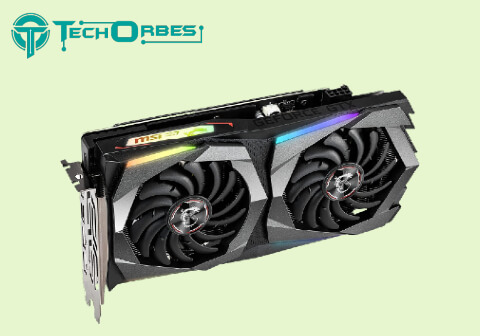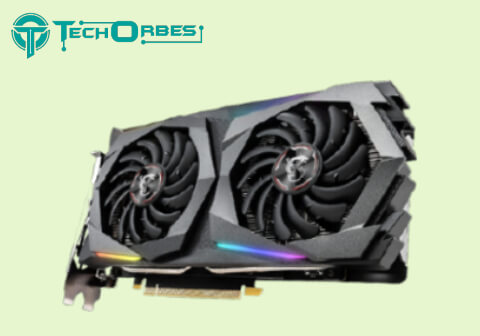MSI Gaming GeForce GTX 1660 (Testing + Comparison)
The MSI Gaming GeForce GTX 1660 GPU from Nvidia makes one wonder how much further the Turing architecture can be pushed. The initial batch of Turing GPUs, which include real-time ray tracing and deep learning cores, are the most incredible graphics cards currently available.
However, the TU116 utilized in the GTX 1660 Ti sacrificed these features to target a more accessible pricing point. The GTX 1660 cuts cost even further by choosing commonly available (and hence less expensive) GDDR5 memory over GDDR6.

The end effect is precisely what you would anticipate: a slightly slower but even cheaper GPU with fewer CUDA cores and other components. It’s nice to get more performance for less money, but with graphics cards, it’s never easy to compete with the previous generation.
The GTX 1660 will outperform the GTX 1060 6GB in terms of performance thanks to various architectural improvements, faster clock rates, and more shader cores, but this won’t be a significant improvement. For this reason, especially for budget and mainstream gamers, I usually advise attempting to skip one or two hardware generations before upgrading.
As a result, the GTX 1660 is better suited to serving as a replacement for an outdated GTX 960 or earlier GPU. 1660 is a fantastic upgrade if you currently have such a card, but anyone running a GTX 970 or higher will likely want to hold out a little longer (instead, select a quicker and more expensive GPU like the GeForce RTX 2060).
MSI Gaming GeForce GTX 1660

Specifications
- 6GB GDDR6 Video Memory
- 192-Bit Memory Interface
- NVIDIA GeForce GTX 1660 Super
- Outlets And Voltage Differ Internationally
We also get a sense of how many improvements were made to the Turing architecture, with 50% more transistors than GP106 but just 20% more CUDA cores. Enhanced color compression, quick FP16 compatibility, variable rate shading, and concurrent FP and INT pipelines are all present.
Still, the degree to which they strengthen performance varies by game and at the moment, no games employ FP16 to do so (it was in Far Cry 5 but later removed). Also, keep in mind that some of the extra transistors might support GDDR6 memory. GDDR5 and GDDR6 are not pinned compatible; thus, even though the GTX 1660 and 1660 Ti both feature 6GB VRAM, the memory controller must handle both.
Since Nvidia doesn’t offer Founders Editions or reference designs for its entry-level products, each card is a “unique” design in some way. As opposed to the GTX 1660 Ti samples I evaluated, Zotac was the first company to send me a GTX 1660 for review.
This card has reference clocks. There will undoubtedly be factory-overclocked variants available from Zotac and the other AIB partners, but at least, in this case, we can see the performance level as is.
Despite having two cooling fans, the Zotac Gaming GTX 1660 is not spectacular. Its length of just 173mm (6.83 inches) makes it essentially a mini-sized card that can fit in tiny cases despite the two fans.
It has a dual-slot design, like almost all current graphics cards, and although it’s not strictly necessary, the card uses a single 8-pin PEG power connector. (That’s according to Nvidia’s specifications; it’s probably best to err on the side of caution since a single 6-pin PEG connector combined with an x16 PCIe slot should be able to supply up to 120W.)
However, by using an 8-pin connection, Nvidia can ensure that cards don’t draw more power than the PCIe slot can handle. One HDMI 2.0b port and three DisplayPort 1.4 connections are included on the Zotac for video outputs, and all four results can operate simultaneously. You will need to bring your adaptor if you have an older monitor that requires a DVI-D connection.
There are no twin VBIOS chips, RGB LEDs, lighting, or high-end features. However, I don’t mind because anyone searching for such traits would typically be better off spending more money and purchasing a GTX 1660 Ti or RTX 2060.
GeForce GTX 1660 Overclocking
This specific card is a fantastic example of how much overclocking headroom is available for enthusiast GPUs because it doesn’t include any glitzy frills. The boost frequency is theoretically 1785MHz; however, throughout several generations, Nvidia’s GPUs have seldom operated at speeds lower than that, frequently exceeding the boost clock in games (though not necessarily in GPU compute workloads).
The GTX 1660 runs at 1845–1905MHz during testing at stock clocks, reaching a maximum temperature of 67C. The GTX 1660 is probably operating much below its 120W TDP rating because the system power draw is only 250W, but at least half of that generates from the motherboard, RAM, CPU, and other components; this does not take into account PSU inefficiency, which would be actual power draw at 225W.
I increased the power limit to 111 percent, the fan speed to 75 percent, and the core voltage slider in MSI Afterburner to +100 for overclocking. Then, when I adjusted the VRAM and core clocks, I repeatedly ran the 3DMark Time Spy stress test.
Since the GTX 1660 uses GDDR5 memory, it will never be able to compete with a 1660 Ti. (I was able to increase the performance of the Asus 1660 Ti to 15 GT/s and the EVGA 1660 Ti to 14.7 GT/s.) I raised the GDDR5 from 8 GT/s to 9.4 GT/s (+700MHz) with the Zotac GTX 1660, a 17.5 percent improvement.
I was only able to enhance the GPU clock by 125MHz, which led to consistent clock speeds of 1950–2010MHz in games, a gain of 5–6%. The combined performance of the overclocked GPU in games is roughly 10% quicker than at stock.
Individual outcomes will differ slightly, but it’s a decent starting point estimate. Although the better models will likely achieve somewhat higher speeds and have their core clocks factory overclocked, I wouldn’t advise spending much more money on a card like that.
Pros
- Very affordable
- Great for 1080p gaming
- Efficient and quiet
Cons
- Modest gains over 1060 6GB
Global Rating
4.7 Out Of 5 Stars
Product Comparison
The GPU at the heart of the GTX 1660 is the same TU116 as in the 1660 Ti; however, two SMs are disabled, resulting in 128 CUDA cores, and eight texture units are also deactivated. Comparing the GPU to the GP106 found in the GTX 1060 may be more intriguing.
Die size grew from 200mm2 to 284mm2, and transistor counts went from 4.4 billion to 6.6 billion. I’ve mentioned it before, but in practice, TSMC’s 12nm technology seems to be little more than an improved version of its 16nm technology, or what Intel would have called 16nm+. We’ll have to wait until Nvidia switches to TSMC’s 7nm node, but it should experience much more significant benefits.

The 7 nm “Navi 10” silicon, which has an astonishing 10.3 billion transistors jammed into a 251 mm2 die, powers the Radeon RX 5700 XT. Navi is a more conventional GPU than the “Vega 20,” as it simply contains the GPU die and is surrounded by memory chips. AMD chose the more affordable 256-bit GDDR6 memory over novel design options like HBM2.
Navi has a good memory bandwidth of 448 GB/s at a memory frequency of 14 Gbps. Additionally, it has full backward compatibility for earlier versions of PCIe and the most recent PCI-Express gen 4.0 x16 host interface, allowing you to use it with AMD’s new Ryzen 3000 processors on motherboards with the X570 chipset.
In its marketing, AMD frequently uses the buzzwords “7 nm” and “PCIe gen 4.0,” as if to imply that Navi is a generation ahead of NVIDIA’s Turing, which is constructed using 12 nm technology and supports PCIe gen 3.0.
Performance And Testing
I’m utilizing a revised list of games for this evaluation; essentially, I’ve replaced some older games with more recent ones (Hitman 2 returned Hitman, for example) (2016). The newest inclusion, Division 2, results in a fortunate 13 games tested. In the past week, I’ve also retested Deus Ex, Fortnite, and Hitman 2 to fix any errors.
The GTX 1660 uses the most recent 419.35 drivers from Nvidia, which were built specifically for testers ahead of the product’s release. Other Nvidia cards are typically tested with 148.91 drivers, whereas AMD cards are usually tested with 19.2.1 or newer drivers (19.3.1 for the most recent retests/additions).
My GPU test system uses a Core i7-8700K overclocked to 5.0GHz and other top-tier components to reduce CPU bottlenecks during testing. If you don’t have AdBlock installed, you can see all the information in the boxout on the right. The test setup may be overkill for graphics cards in the budget and midrange, but it enables all graphics cards to perform to their maximum capacity.
Testing is done in “ultra” quality in 1080p, 1440p, and 4k, as well as “medium” quality at 1080p. In most games, the ultra preset maximizes every setting; however, in games without presets (such as GTA 5’s advanced graphics menu, which includes super scaling), I have manually maximized all settings.
Certain games penalize cards with less than 6GB or even 8GB of VRAM in these settings, but the GTX 1660 should be fine in most cases. Since 4k is unquestionably not a good aim for this GPU, I’m merely going to include the summary chart at that resolution.
The GTX 1660 performs well, starting at 1080p medium. It’s not much quicker about 12 percent faster than the previous GTX 1060 6GB, but at least it’s faster and cheaper. Additionally, it is over twice as fast as a GTX 1050 and 20 percent faster than the 1060 3GB and a GTX 970.
There is a chance for a significant performance gain if you’re holding onto an older GPU, as performance at the time 1050 was released likewise almost identical to the GTX 960 2GB. Besides that, the GTX 1660 Ti is 15% quicker than the 1660, mainly because of its increased memory clocks.
The RX 590 from AMD, meanwhile, nearly equals the performance of 1660 despite being a less effective card (the RX 590 draws around 50W more power while gaming.) Additionally, the 1660 is 25 percent quicker than the RX 570 4GB and 11 percent faster than the RX 580, 8GB, while currently being more expensive.
Even if switching to 1080p Ultra doesn’t significantly alter anything, 1660 usually performs marginally better in each of the comparisons above by a few percent (other than the 1660 Ti, which increases its lead by 1 percent).
Select games, such as Metro Exodus, Assassin’s Creed Odyssey, and Deus Ex Mankind Divided, are extremely demanding and the GTX 1660 isn’t able to average 60 frames per second or higher in those games. Overall, it’s a decent 1080p gaming card, marginally outperforming the 1060 6GB that debuted a few years ago.
Final Verdict
It was simple to download and install the drivers, tools, and software for MSI Gaming GeForce GTX 1660. Even though it isn’t a very high-end gaming card, if you’re not a severe and die-hard gamer, this is the right card for you.
The low-value score is due to the prices being above the suggested retail, but this could improve when the epidemic weakens and the supply chain becomes more robust. This card is a suitable replacement for my previous card, which was on the verge of not being adequate for all that I do with 4K multimedia editing and production.
I have three monitors set up, so the three Display Ports work flawlessly to power them. This freed up the HDMI port so that I could power my 4K UHD projector. This GPU doesn’t pause when all of these things are going at once, but the variable speed cooling fans ramp up.
The fans on this card slow down so much that you can’t even hear them when they are not needed or the card is under a low graphic processing load. This is a wonderful feature, as they are not very noisy at full load or speed, to begin with.

Rayssa is a native American. A group of specialized individuals raised her with a passion for gaming. Here she discovered that computer games can expand your creative mind to infinite possibilities. In recent years, she has gone beyond gaming as a means of entertainment to enjoy it as a passio
